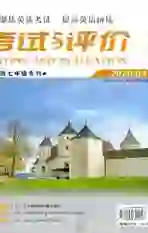Unit 8 词语和句型考点归纳
2020-10-23王秀凤
王秀凤
1. spend v. 花(时间,钱等)
spend用作动词,其后宾语通常是时间、金钱。在主动语态中,句子的主语必须是人,而且后面不能用动词不定式作宾语。常见搭配:spend on sth. 意为“在……上花费(时间/金钱);spend... doing sth. 意为“花时间做某事”。如:
She spent the whole evening reading. 她整个晚上都在读书。
Mike usually spends too much time doing his homework. 迈克通常花费很多时间做作业。
辨析:take, pay, spend
take常用来指“花费”时间,句子的主语通常是表示物的词语。常见句子结构:It takes sb. sometime to do sth. 花费某人时间做某事。如:
How long did it take you to do this job?你做這项工作花了多长时间?
It takes me two hours to go to school. 我花两个小时到达学校。
pay意为“支付”,主要指主语(人)买某物付多少钱(给某人)。常见句子结构:主语(人)+pay for sth. / pay+钱+ for sth. 如:
You have to pay for the book if you lose it. 如果你弄丢了这本书,就得赔偿它。
Jim wants to pay 5000 yuan for a watch. 吉姆想花5000元钱买块手表。
2. across adv. & prep. 过,穿过
across 用作介词,意为“越过;穿过”,指“从物体的表面穿过”,强调的是“从一端到另一端”,常与street, bridge, river连用。常用短语across from意为“在……对面”。如:
The workers built a bridge across the river. 工人们修了一条横跨这条河的桥。
The river is too wide. We cant swim across. 这条河太宽了,我们游不过去。
辨析:cross & across
cross用作动词,意为“越过;穿过”。其后接宾语,相当于go across。crossing为名词,意为“路口”。如:
He crossed the street and arrived at the shop. 他穿过街道并且到达了商店。
Lets go and help the blind man cross the road. 让我们去帮那位盲人过马路吧。
3. turn v. 转向;翻
turn作动词,意为“转向”。常用短语turn left / right 意为“向左/右转”。如:
The P.E. teacher asks the students to turn right. 体育老师告诉学生们向右转。
拓展: (1) turn作动词时,还可以表示“翻”。 如:
Please turn to Page 88. 请把书翻到88页。
turn作连系动词,意为“变得”。如:
Why does your face always turn red? 你的脸为什么总变红?
(2) turn作名词时,意为 “(依次轮流的)机会”。如:
Its your turn to cook today. 今天轮到你做饭了。
4. enjoy v. 享受;喜欢
enjoy通常后接名词、代词(宾格)作宾语,动词作宾语时,必须用动名词(V+ing)形式。常见的词组搭配:
(1) enjoy sth. 喜欢某物。如:
Mike enjoys apples. 迈克喜欢苹果。
My friends are enjoying the dinner. 我们的朋友们在津津有味地吃晚餐。
(2) enjoy doing sth. 喜欢做某事。 如:
I enjoy reading in the sofa. 我喜欢在沙发上看书。
Some people enjoy eating fast food in the restaurant. 一些人喜欢在餐馆吃快餐。
注意: enjoy后接动词时必须接动名词形式,不能接动词原形或动词不定式。
enjoy oneself 意为“玩得开心”。enjoy oneself = have a good time =have fun 如:
I am enjoying myself in Canada right now. 此刻在加拿大我玩得很开心。
Susan enjoys herself in the park.苏珊在公园里玩得开心。
5. in front of, in the front of
in front of意为“在……的前面”,特指某一范围以外的前面。如:
There is a tall tree in front of the house. 房子前面有一棵大树。(房子外部的前面)
in the front of意为“在……的前面”,强调某一范围以内的前面。如:
Miss Brown is standing in the front of the classroom. 布朗小姐站在教室的前面。(教室内部的前面)
in front of的反义词为behind (在某一物体的后面), 指外面;
in the front of的反义词组为at the back of (在某一范围的后头),指内部。
6. left adv. & n. 向左边;左边
(1) left 作副词,意为“向左”。如:
Please turn left. 请向左转。
(2) left作名词,意为“左边”。如:
Look! Jenny is on my left 看!珍妮在我的左边。
常用短语:on the left 在左边;on the left of... 在……的左边。
(3) left作形容词,意为“左边的”。如:
The left boy is Tom.左边的那个男孩是汤姆。
【短语链接】
1. post邮政→post office 邮局
2. across穿过→across from在……对面
3. front前面→in front of在……前面
4. turn转向→turn right / left 向右/左拐
5. free免费的→be free 免费
【短语串串】
1. police station 警察局 2. pay phone 付费电话 3. go / walk along / down... 沿着……走4. at the first crossing 在第一个十字路口 5. on your left / right 在你的左边/右边
6. watch sb. doing sth.看见某人正在做某事
7. enjoy doing sth. 喜欢做某事
【难句解析】
Is there a hospital near here? 这附近有家医院吗?
问路一般包括四个方面:引起话题;询问路在何方;指路;致谢。
问路常用句型
1. Excuse me, can you tell me the way to..., please? / Can you show me the way to...? 你能告诉我去的路……吗?
2. Can you tell me how to get to...? / Can you tell me how I can get to...? 你能告诉我怎样到达……吗?
3. How can I get there? / How can I get to...? 我如何才能到达……?
4. Wheres...? 请问……在哪?
5. Which is the way to...? 请问哪条是到……的路?
6. Is there a... near here? 這附近有……吗?
